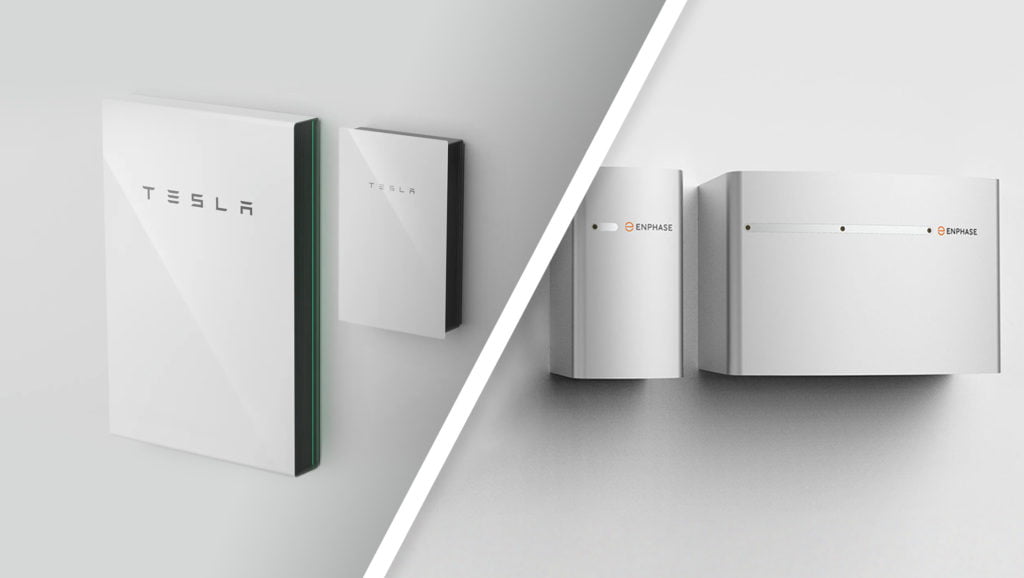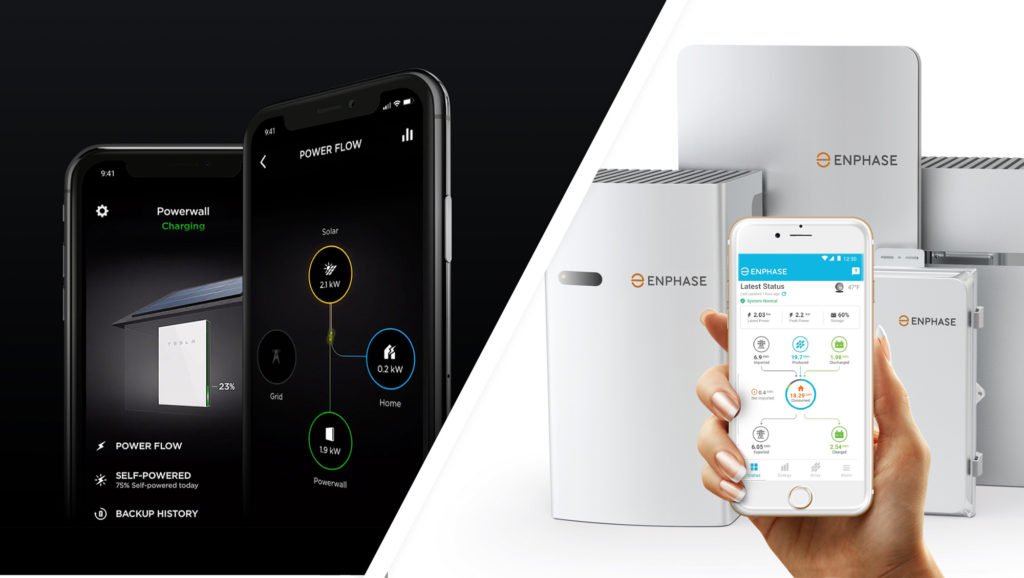When speaking about solar energy storage systems, reliability and protection in the event of blackouts are the first criteria. Solar batteries can look stylish or have more or less power. But when a power outage happens, the solar battery must function uninterrupted.
So, home batteries are designed to store energy from the solar panels to use at night, or when the weather is cloudy, or when there is an outage. Switching to solar energy and installing a solar battery storage system will make you less dependent on the utility grid. Moreover, with net metering policies, homeowners are investing more in-home battery backup technologies.
There are many types of solar batteries available in the solar market. With the solar industry rapidly changing, it becomes even more complicated to choose your home and solar system’s correct solar battery. Hence, let’s compare two of the most popular solar batteries: Tesla Powerwall and Enphase battery.
Price Difference
Tesla company has changed the solar industry since its release in 2015, pushing home energy storage into the mainstream. With Tesla products, solar systems became more reliable and cost-effective. The Tesla Powerwall is considered to be one of the best energy storage solutions in the solar industry. It was the first high-voltage battery for home use. Tesla Powerwall has many valuable features, and of course, a reasonable price.
Powerwall 2 Cost
In 2022, Tesla Powerwall installation price includes the Powerwall battery, Gateway management system, and the installation cost. In case you install more than one battery, you will save on the battery cost (about $4,000).
Enphase company was founded in 2006. It is one of the world’s leading solar microinverters and one of the leading energy storage system manufacturers. Enphase batteries are designed to work with energy and heating manufacturers. Enphase’s advantage is that the batteries have integrated Enphase microinverters, eliminating a single point of failure in the entire system while guaranteeing the most uptime.
The Enphase battery storage system is a safe, reliable and simple solution on the market. The installers can customize the system size based on the homeowner’s needs.
You will find no dangerous, high-voltage electricity in the batteries. Moreover, Enphase storage is the first and only microinverter storage system to be tested under UL’s test method for thermal runaway fire propagation, earning the UL9540A certification.
Tesla Powerwall 2 For Sale
Tesla Powerwall is a cobalt-based lithium battery. It is a good choice in case of blackouts. The Tesla Gateway is the management system for the Powerwall. Besides, you can monitor your battery operations through the Tesla Powerwall app.
The Enphase battery is a lithium-iron-phosphate battery. The battery is only compatible with M and IQ serier Enphase microinverters.

Enphase batteries are managed by Enphase software. It gives you complete control over the system. The Enlighten app of the Enphase system will help you track and monitor your energy consumption in real-time. So, it will become easy to make your energy usage smarter and save on the bills. The Enphase system supports PV systems, battery storage and monitors power consumption with one package.
Power Output
The storage capacity is another essential factor when choosing a battery system. Tesla Powerwall comes in one size with 13.5 kWh. As for Enphase batteries, they come in two different sizes: 3.36kWh and 10.08kWh. It allows the maximum flexibility to custom-size any system for the individual homeowner’s needs. Unlike the Powerwall, you can add more than one bank at a time, a maximum of 14 units per installation.
Enphase batteries have a longer charging and discharging time. Charging a single Enphase battery will take about 4.5 hours. You can also set multiple batteries together and again spend 4.5 hours.
It takes about 2 hours to charge the Tesla Powerwall at 3.3kW fully. Today, Tesla Powerwall is one of the most widely installed solar battery backup systems for home.
Battery Backup
If you are concerned about power outages, on that occasion, both batteries are designed to be the right choice for you. If you plan to have your appliances backed up and run if the grid goes down, both battery systems will be an accurate choice, providing backup protection.

With the smart features of the battery systems, you can also analyze your consumption, understand how you utilize your power, optimize your power usage, and lower your grid consumption. However, if you use little electricity per day, like 4-5 kWh, it can be more efficient to go with the Enphase batteries.
Ease Of Installation
While both solar batteries are high-quality and safe, the Tesla Powerwall installation process is a bit hard. What for Enphase batteries, you can install them in just a few hours. Moreover, they provide quick and easy plug-and-play installation and interconnect with standard household AC wiring.
Utility Grid
It runs on solar energy and is especially handy during power outages. Its domestic energy storage potential allows solar customers to stay off the grid.
There is a significant difference between these two types of batteries. The Enphase Battery is a lithium iron phosphate formulation that is devoid of cobalt. This battery backup is one of the safest on the home battery market, keeping rising power bills under control, because the thermal runaway problem isn’t a concern.
Tesla Powerwall 2 Specification
The Tesla Powerwall 2 has a nickel manganese cobalt battery chemistry – making it one of the most efficient and powerful batteries on the market. It is also equipped with several safety features that prevent overheating. Both the Tesla Powerwall 2 and Enphase home energy storage are well thought of because of their price, and they can handle severe weather, making them cost effective with your solar panels and solar production.
The Enphase Battery provides power during extreme weather conditions and maintains the ability to absorb power. There is a feature on the Enphase that detects approaching weather and will begin prioritizing energy so that enough is stored to make it through the storm. The Tesla Powerwall is a water-resistant battery. It is built to withstand all types of weather, making it an ideal option for all environmental types, no matter how hot, cold, wet, or dry.
While these are two different solar batteries, both of them provide extensive power backup for your home and can assist with utility costs. Both the Enphase Encharge and the Tesla Powerwall are excellent products with their own advantages. You’ll have to consider the specific circumstances of usage to determine which product is best for your home.
Although it’s difficult to know which battery would be best for your situation, we can go head-to-head with the features between the two batteries and compare some of the standout features that make each one unique.
Best Solar Battery Backup System For Home
With the Enphase IQ battery, you have the option of connecting multiple storage systems to maximize backup potential for energy stored from your solar panel system. The Encharge IQ comes in two different sizes: Encharge 3™ and Encharge 10™, and both produce high power with the way they store energy consumption.
The Enphase IQ, like most other solar batteries from prominent manufacturers, is a lithium-ion battery. However, instead of Nickel Manganese Cobalt, Enphase uses Lithium Iron Phosphate (LFP) chemistry (NMC).
What this means for you is that you’re getting one of the safest batteries available: Thermal runaway fires aren’t a concern with LFPs since they stay cool. Furthermore, the Enphase IQ’s cells have been safety certified, and the battery is passively cooled, meaning there are no moving components or fans.
Solar Battery Backup System For Home
You can monitor how much energy you’re utilizing by using the Enphase app. With Enphase IQ inverters, you can check how your solar panels are doing and how much energy they are consuming in real time, all in one app. You may also receive weather alerts straight from the National Weather Service with Storm Guard.
Enphase created a unique design that backs up your backup system: multiple microinverters placed in the energy storage unit.
What this implies for you is that if one microinverter fails, the system will continue to work properly thanks to the remaining microinverters. Most other battery systems, on the other hand, employ a single string inverter, which means that if it fails, the entire battery would fail.
Solar Power With Battery Backup
In conclusion, both solar batteries in the Enphase Battery versus Tesla Powerwall 2 help with energy use, produce more power and electricity than others, and are made by premier solar battery and solar system firms. Both batteries are excellent for storing energy, are dependable, and are simple to operate with a touch of your screen. In addition, the Tesla app is an exceptionally useful tool.
What’s the best home batteries solution to produce electricity for your situation? Who has the best battery storage in the solar industry? Get in touch with a professional from our company who can answer all your questions about how we can lower your electricity bills with energy usage from the battery system with the right solar battery for your needs and battery capacity, and assess all the factors to find the perfect battery solution and solar system battery storage equipment for you.
There are many Enphase batteries and Tesla Powerwall alternative battery systems worldwide. But the recognition of the last two makes them desired and inquired. What battery will work better for your home depends on your home location, your energy consumption, and the features you want. When choosing a solar battery storage system, it is better to speak to a professional and qualified company to understand your needs better.
Author of a publication: Irene Abgaryan



